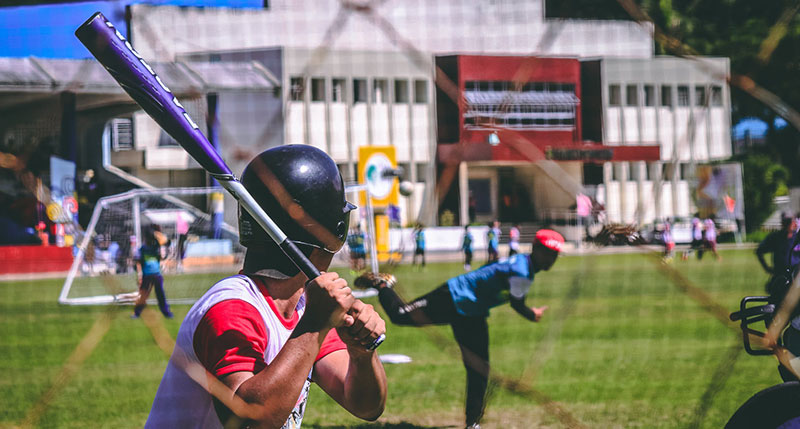Back to school season often means back to sports—so it’s a smart move for parents to bring their student athletes in for a comprehensive eye exam before sports seasons begin. This exam may be a game-changer for your student athlete. Young eyes grow and change rapidly, and we often see significant changes in students’ eyes from year to year as they mature.
Good eyesight is the key to good grades, too: An estimated 80 percent of your student’s ability to learn is tied to their eyes and visual ability.
In addition, here’s why it’s critical to find out if your student athlete’s eyes are ready for the 2021 sports season:
Depth Perception for the Win!
Whether it’s a tennis ball zooming across the court at warp speed toward your student athlete, or a lacrosse ball coming at them across the field, depth perception is the key to judging how far away or close an object is. The eyes must work together (which we call “eye teaming”) to correctly evaluate how fast the ball is moving so your student’s brain can determine when to react to hit, catch or kick that speeding ball. It’s an incredibly intricate process, and there are multiple working parts and fine motor skills involved. The one thing all of the aspects in this process have in common is the human eye.
With two eyes, people enjoy binocular vision, and thus the ability to perceive depth perception. Depth perception simply means we can see an object in three dimensions—width, length and depth. In sports, this gives us the ability to see an object (even a moving one) and make a judgment about its distance from us and the speed at which it is moving away from or toward us.
Depth perception is key for multiple life skills, including walking, climbing stairs, balance and driving, to name just a few. It’s also critical to your student’s athletic performance. Therefore, it’s a parenting “best practice” to bring them in for an eye exam so your optometrist can be sure they see their best in the classroom and on the field or court.
Depth Perception Helps Athletes Excel
Sports that involve a ball—baseball, tennis, lacrosse, soccer, volleyball, football, dodgeball, badminton, hockey (ok, a puck), golf or ping pong and many others—require athletes to have a sharp ability to track that moving ball or puck through space. Then, at the appropriate time, they can choose to catch it, hit it, or pass it. These sports-related visual abilities rely on depth perception, which is why that visual skill is absolutely crucial to perform your best in sports.
In addition to strong athletic performance, depth perception increases your student athlete’s safety on the field or court. Balls, birdies and pucks accelerate at high speed. If your student isn’t able to perceive the distance of that oncoming object and move appropriately out of the way, it could result in injury. Your optometrist will also check your child’s peripheral vision and eye teaming skills, which provide additional athletic ability and safety during the game.
Finally, sports goggles are a must-have item for all student athletes. You protect their head, elbows, knees and shins—it’s arguably much more critical to protect their eyes!
What Causes Poor Depth Perception?
To enjoy good depth perception, your two eyes must be able to focus accurately and perceive both distant and up-close objects clearly. In addition, you need good eye teaming skills so that the information each eye provides to the brain about those distant and up-close objects is accurate and interpreted correctly by the brain. The brain analyzes and merges the input each individual eye provides and blends them together so that you see one single image in three dimensions―which is what you “see” as your field of vision.
Unfortunately, if one eye underperforms and doesn’t send accurate nerve impulses, the brain doesn’t receive sufficient information to form an accurate visual field. This can result in low depth perception and sub-par athletic performance.
When one eye enjoys strong visual acuity while the other doesn’t, depth perception can suffer significantly. The good news is, your optometrist will ensure that both eyes are performing at their best, which can cause a dramatic improvement in depth perception.
Two common conditions that contribute to depth perception challenges are:
- Strabismus. This condition is a misalignment of the eyes in which one eye “points” or looks in a different direction from the other. It could be pointing to the right, left, down, up—or even diagonally.
- Amblyopia. This condition is sometimes known as “lazy eye.” It refers to the inability of one of the eyes to perceive a clear image to share with the brain. In response, the brain ignores the signals from that eye.
The key to reversing depth perception challenges due to either of these two conditions is early diagnosis! That’s why an annual eye exam during childhood is so important.
During your student’s annual comprehensive eye exam, your optometrist will check for signs of these potentially challenging conditions, in addition to many other eye-teaming skill issues that could impact athletic performance.
Our goal is to ensure that your student’s vision is at its best to achieve excellent performance both while playing sports and in the classroom.

